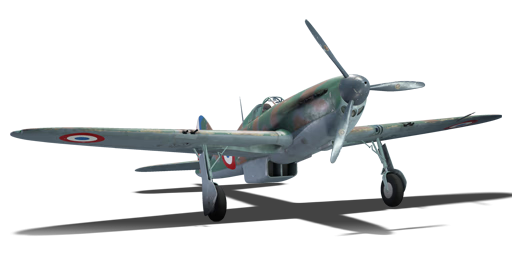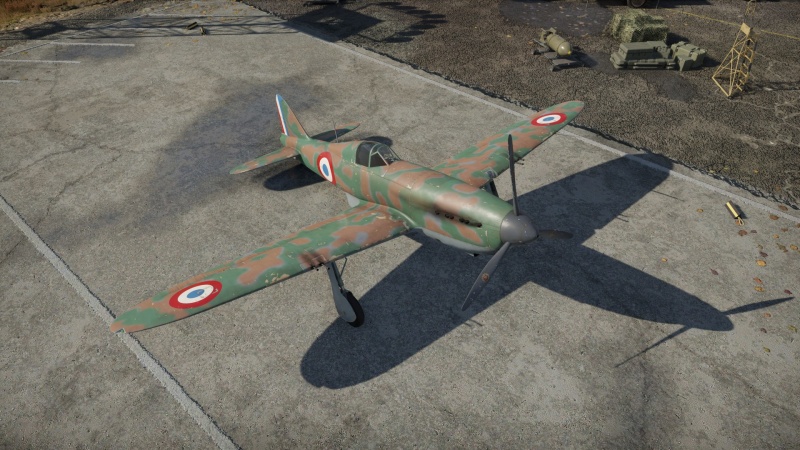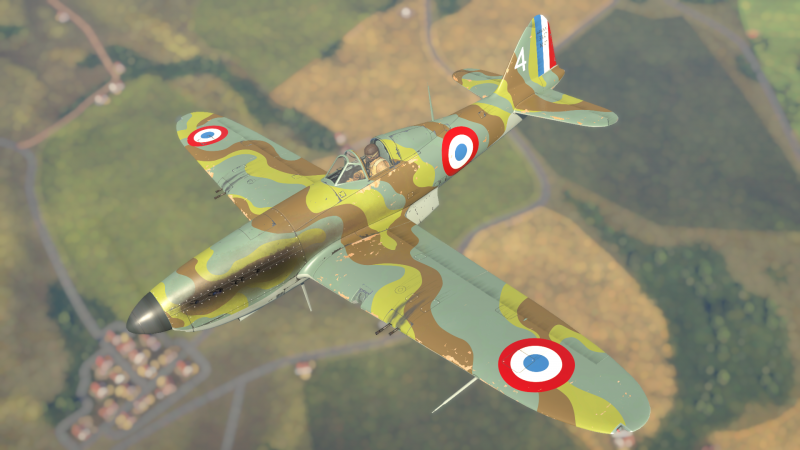V.G.33C-1
Contents
Description
The V.G.33C-1 is a rank II French fighter with a battle rating of 3.0 (AB) and 2.7 (RB/SB). It was introduced in Update 1.73 "Vive la France".
The V.G.33 can adequately deal with planes with similar BR. It is quick, nimble (to an extent), and powerful. Its machine guns and single propeller-mounted 20 mm do a decent amount of damage. However, it lacks armour, so take that into account when engaging other aircraft.
General info
Flight performance
The aircraft flies well, as would be expected of a light fighter. Although it's rate of climb is not the best, it is fast and retains energy well, allowing it to be used as a successful energy fighter. It has a good enough turn time, although it's not good enough to compete with the British and Japanese fighters at the BR. It is usually fast enough to outturn common foes such as Fw-190s and Bf109s.
| Characteristics | Max Speed (km/h at 4,500 m) |
Max altitude (metres) |
Turn time (seconds) |
Rate of climb (metres/second) |
Take-off run (metres) | |||
|---|---|---|---|---|---|---|---|---|
| AB | RB | AB | RB | AB | RB | |||
| Stock | 537 | 523 | 9500 | 19.7 | 20.5 | 10.4 | 10.4 | 300 |
| Upgraded | 588 | 558 | 18.8 | 19.0 | 20.4 | 13.4 | ||
Details
| Features | ||||
|---|---|---|---|---|
| Combat flaps | Take-off flaps | Landing flaps | Air brakes | Arrestor gear |
| X | X | ✓ | X | X |
| Limits | ||||||
|---|---|---|---|---|---|---|
| Wings (km/h) | Gear (km/h) | Flaps (km/h) | Max Static G | |||
| Combat | Take-off | Landing | + | - | ||
| 800 | 320 | N/A | N/A | 270 | ~12 | ~9 |
| Optimal velocities (km/h) | |||
|---|---|---|---|
| Ailerons | Rudder | Elevators | Radiator |
| < 350 | < 350 | < 430 | > 340 |
Survivability and armour
- 3 mm Steel plate between engine and oil cooling system.
Due to the plane's general lack of armour, except for a 3mm steel plate between the engine and the oil cooling system, it's survivability is limited. . Although its airframe can survive more punishment than would be expected of such a lightweight wooden structure, it should not be relied on as an asset of this aircraft. Think of a hit survived as a lucky roll of the dice. The best policy for survival in this aircraft is to not be hit.
Modifications and economy
Armaments
Offensive armament
The V.G.33C-1 is armed with:
- 1 x 20 mm Hispano 404 cannon, nose-mounted (60 rpg)
- 4 x 7.5 mm MAC 1934 machine guns, wing-mounted (500 rpg = 2,000 total)
The aircraft's armament can be powerful, but only in the right circumstances and when used correctly. As with many French aircraft, it possesses a potent propeller-hub mounted Hispano cannon, but it has very limited ammo. This is both a blessing and a curse, as while it does help with learning to conserve ammo and improving leading, it can be a steep learning curve, especially for those with less capable aim. The 20mm is supported by 4 x 7.5 mm MAC 1934 machine guns. These machine guns are also found on many French planes. While they have poor damage when stock, once the tracer belt is unlocked, these guns are quite potent, although they should not be relied on for larger targets such as bombers. It is recommended to use weapon selection to conserve 20mm ammunition for only when a hit is guaranteed, to make the most of the limited ammunition supplies.
Usage in battles
The V.G.33C-1 is a very competitive aircraft at its battle rating, with decent climb rate, good speed and good manoeuvrability. Its biggest weaknesses are its lack of ammunition and lack of armour. To take advantage of this plane, it's best to side climb and exploit any opportunities that will present themselves. Both turnfighting and BnZ tactics work well with this plane but turnfighting is the better of the two due to the lack of ammo, it also allows for, generally speaking, a better and cleaner shot. Trigger control is key when flying this plane. Though not as manoeuvrable as a spitfire, it can sustain a turnfight with an F6F, Yak-7 or Yak-9, but against a fighter like a I-16, you can use your high horsepower engine in a steep climb while dodging out of the way of its guns, to stall it out so you can finish him off with your 7.5 mm MGs.
In mixed ground battles, your anti-tank capabilities are limited as the penetration of your 20 mm Hispano 404 cannon is insufficient. Up close, you can penetrate the roof of the Pz.III, and perhaps the engine deck, depending on angle. Your main target shouldn't be ground vehicles, but strike aircraft and fighters. With your relatively weak armament, bombers will be tough to bring down, and the fragile inline engine cannot take much fire before becoming inoperable.
Manual Engine Control
| MEC elements | ||||||
|---|---|---|---|---|---|---|
| Mixer | Pitch | Radiator | Supercharger | Turbocharger | ||
| Oil | Water | Type | ||||
| Not controllable | Controllable Not auto controlled |
Controllable Not auto controlled |
Controllable Not auto controlled |
Separate | Not controllable 1 gear |
Not controllable |
Pros and cons
Pros:
- 20 mm cannon is very dangerous, especially with high explosive ammunition
- Relatively fast
- Excellent manoeuvrability
- Impressive efficiency of 4 x 7.5 mm MAC 1934 machine guns
- Amazing climb rate, about as good as the BF-109s
- Excellent high altitude performance
- Amazing energy retention, probably the best for what it faces
- Lightweight can zoom climb away from most enemies in the middle of a dogfight
- High energy retention when exiting a dive
Cons:
- 20 mm cannon has very small ammo pool
- 20 mm cannon under-performs until you research new ammunition belts
- Weak survivability, especially the fuel tanks and inline engine
- Below average roll rate
- No combat take-off flaps
- The engine overheats quickly at low altitude (below 4,000 m / 12,000 ft)
History
The VG33 C-1 was a member of the VG series that was designed in 1936. It was aimed to provide a solution to the French Airforce's lack of modern fighter aircraft. To achieve this, it used a wooden structure, which could utilise France's forests, alleviating the shortages in aluminium. It was designed to the same contract as the C.R.714 and the Bloch MB.700. The Vg.30 was originally intended to be powered by a Potez 12Dc inline engine, but due to development issues with the engine, the prototype first flew in October 1938 with a Hispano-Suiza 12Xcrs. The Vg 33 itself was a modified version of the VG-31, which used the Hispano-Suiza 12Y-31 and which first flew in 1939, with great success.
Media
- Skins
- Videos
See also
Links to the articles on the War Thunder Wiki that you think will be useful for the reader, for example:
- reference to the series of the aircraft;
- links to approximate analogues of other nations and research trees.
External links
| Arsenal Aeronautical (Arsenal de l'Aéronautique) | |
|---|---|
| Fighters | VB.10-02 · VB.10C-1 |
| V.G.33C-1 | |
| France fighters | |
|---|---|
| Dewoitine | D.371 · D.371 H.S.9 · D.373 · D.500 · D.501 · Pallier's D.510 · D.520 |
| Morane-Saulnier | M.S.405C1 · M.S.406C1 · M.S.410 |
| Arsenal | V.G.33C-1 |
| Bloch | M.B.152C1 · M.B.157 |
| Caudron | C.R.714 |
| Sud-Ouest | S.O.8000 Narval |
| American | H-75A-1 · H-75A-4 · ▄P-39Q-25 · ▄P-40F-5 Lafayette · ▄P-47D-22-RE · ▄P-63C-5 · F-6C-10-NA |
| ▄F6F-5 · ▄F6F-5N · F4U-7 · ▄F8F-1B | |
| Other countries | ▄Seafire LF Mk.III · ▄Yak-3 · Challe's ▄Yak-9T · NC.900 |
| Belgium | ▄Gladiator Mk I · ▄Spitfire FR Mk XIVe |
| Netherlands | ◘Sea Fury FB 51 |






